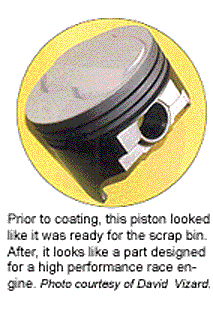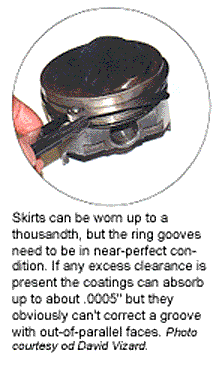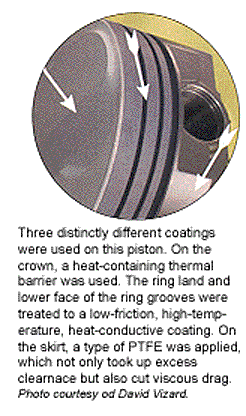Lubricity, heat management, corrosion protection and cosmetics. These are the main benefits that coatings can provide when applied to the surface of various engine parts. But there are different coating materials for different purposes, so the key to maximizing engine durability and performance with coated parts is using the right coating materials in the right places.
Coatings include various types of dry film lubricants, thermal barriers that reflect heat, thermal dispersants that radiate heat, oil-shedding coatings and cosmetic coatings that prevent rust and may also reflect heat.
Most of the companies who are involved in coating technology are very secretive about what is in their products, and especially how their products are applied and cured. Most do the coating process in-house and do not sell or license their coating technology to outside shops. There are some “do-it-yourself” coating products available, but every coating supplier we interviewed cautioned against trying to apply coatings yourself. “It takes a professional who knows what they are doing to get the right results,” said one supplier.

Proper surface preparation is essential to remove contaminants and to ensure good adhesion of the coating with the base metal. One coating supplier said that 85 percent of the work that goes into coating a part is surface preparation. Surfaces can be prepped for coating by media or sand blasting. The material is then sprayed on, allowed to dry, then oven cured under carefully controlled conditions to achieve a long lasting bond. The oven temperature must also be limited when curing aluminum parts so the metal is not annealed (softened).
Dry Film Lubricants
Dry film lubricants typically contain such ingredients as molybdenum disulfide, tungsten disulfide and/or PTFE (Teflon) in a thermosetting polymer binder (water or solvent based). Dry film coatings are typically formulated to provide surface lubricity and to protect against friction, galling and wear. A dry film coating provides an extra margin of safety if oil pressure is lost (at least for awhile), and helps prevent metal-to-metal contact under extreme pressure or following a dry start. Dry film lubricants are used primarily on piston skirts, engine bearings and journals for added protection, and also on intake and exhaust valve stems, valve springs, rocker arms, pushrods, lifters and cam lobes for the same purpose.
Dry film lubricants that contain moly as their main ingredient are typically “fluid retaining” coatings that actually hold oil on the surface. Under heavy loads, the ability to hold oil prevents the oil film from being squeezed out from between the parts. This improves lubricity and reduces wear. The coating also provides backup lubricity should the oil film be lost.
One coating supplier told a story about a customer who won a championship two years ago thanks to the dry film coating on his piston skirts and bearings. Three laps from the finish of the race, the drive for his oil pump sheared off and he lost all oil pressure. He kept on going and finished the race in second place. When he tore down the engine, the coating had saved his crankshaft, pistons and cylinders. He put the engine back together and went on to win the championship the following weekend. We heard similar stories from several coating suppliers.
The point here is that dry film lubricant coatings on critical parts can take up the slack momentarily if oil pressure is lost. The coating won’t last indefinitely under such conditions, but it may buy enough time to prevent serious damage or to save the engine from total destruction. That’s why many racers today are using dry film coatings as “insurance” on piston skirts, bearings and valvetrain components. Should they lose oil pressure during a race, the coating will hopefully minimize the consequences.

Coated bearings are a good choice for any high revving engine application including drag racing, circle track or even sport compact street engines. Coated pistons are also a good choice for any engine that may be at risk of overheating or is subjected to unusually high combustion or operating temperatures.
Dry film lubricant coatings on piston skirts typically add about .001″ to the piston diameter, so the question often comes up as to how this affects piston installation clearances. One leading piston manufacturer said it is not necessary to compensate for the coating when figuring piston-to-bore clearances. “Just pretend the coating isn’t there,” is their advice. Use the piston size on the box to calculate clearances, not the actual diameter of the coated piston.
A thinner coating is often used on bearings, typically .0002″ to .0003? thick. The coating is thin enough that it should not affect normal bearing clearances so bearings can be assembled with the same clearances as if the coating wasn’t there. Even so, you should still measure clearances to make sure adequate oil clearance exists.
Dry film coatings on bearings typically burnish over a period of time. But even if the coating appears to be wiped away, it typically penetrates the surface and is still able to provide lubricity.
One misconception about dry film lubricants is that they create more horsepower by reducing friction. That would only be true if there were no oil between the parts. But as long as there is an oil film between the parts, the coating does not change friction or the shear characteristics of the oil. Engine drag and parasitic horsepower loss can be reduced, though, when an oil-shedding coating is used on crankshaft counterweights. One coating supplier said coating the crank journals is good for 8 to 10 hp at 7,500 rpm. The oil also runs cooler and experiences less foaming.
Dry film lubricants do lower oil temperatures, anywhere from 15 to 30 degrees, which allows the use of thinner oils with a much greater safety margin. Lower viscosity oils create less drag, so there are some horsepower gains to be found by using thinner oil.
Dry film lubricants that contain a high amount of PTFE (Teflon) are typically oil-shedding coatings. Though Teflon is a slick, low-friction material, it repels oil rather than retains it. For this reason, some coating manufacturers say dry film lubricants that contain a high percentage of PTFE should not be used on bearings or piston skirts. Yet one major aftermarket supplier of engine bearings uses a coating that contains both PTFE and moly on their coated performance bearings. The moly in the coating helps hold oil, while the PTFE provides backup lubricity should oil pressure be lost.
Dry film lubricants can also be used to coat intake runners in manifolds and cylinder heads. According to one coating supplier, this helps reduce air/fuel separation in the intake runners while also insulating the mixture from engine heat. Depending on the formula of the dry film lubricant, some also act as an insulator or heat barrier.
Thermal Barriers
Another way in which coatings can help protect engine parts and also improve performance is by managing heat. Coatings that contain a high percentage of ceramic ingredients are typically poor conductors of heat. Consequently, they can be applied to parts in areas where you want to reflect heat rather than absorb it. This includes the tops of pistons in certain high heat applications, the top ring grooves in pistons, combustion chambers, the faces and heads of exhaust valves, the inside of exhaust ports, and the inside and outside of exhaust manifolds and headers.
When a ceramic thermal barrier coating is applied to the top of a piston, the piston will reflect heat back into the combustion chamber for better combustion and more power. Heat is energy, so the more heat that is retained in the combustion chamber the more energy there is to push the piston down. A cooler piston is also less apt to develop hot spots that can cause pre-ignition and detonation.

Thermal barrier coatings are typically about .001″ to .003″ thick, and help protect the pistons in supercharged or turbocharged drag racing engines, or ones that run on short bursts of nitrous oxide. Nitrous produces a tremendous amount of heat in a very short time, which can be very damaging to unprotected pistons. But a barrier coating also prevents heat from dissipating down into the pistons and rings, which may be counterproductive if the heat persists for a long period of time. That’s why several piston manufacturers do not recommend a thermal barrier top coating on pistons for naturally aspirated engines (without nitrous) or ones that are built for endurance racing. On these kind of applications, you’re probably better off without it.
When applied to the face of intake and exhaust valves, thermal barrier coatings can help the valves run cooler. Coating the face of both valves reflects heat back into the combustion chamber and helps the valves run cooler (especially exhaust valves). One coating manufacturer also recommends coating the backs and stems of exhaust valves with a dry film lubricant to improve lubricity and reduce valve guide wear. On titanium valves, such a coating can protect the valve from erosion. Dry film lubricant applied to the back of intake valves can also reduce the buildup of carbon deposits that disrupt airflow.
Inside the combustion chamber (especially in aluminum heads), a thermal barrier coating can prevent the head from absorbing so much heat. This also improves combustion efficiency, adds power and lowers coolant temperatures. The thermal barrier coating is usually applied to the combustion chambers and inside of the exhaust ports. It may also be sprayed on the intake manifold surface to keep heat away from the manifold.
Thermal barrier coatings can also be applied to the underside and flange surfaces of intake manifolds, and the carburetor or throttle body flange to keep heat away from the incoming air charge. On a normally aspirated engine, every 10 degree reduction in inlet air temperature can increase engine power almost one percent. On a turbocharged or supercharged engine, a 10 degree reduction in inlet temperature is good for up to two percent more horsepower.
One place where thermal barrier coatings work extremely well is on exhaust manifolds and headers. Coating the inside and outside of these parts keeps the heat in the exhaust which increases the velocity of the exhaust gas for reduced backpressure and reversion. The net result is better exhaust breathing and more horsepower, especially at higher rpm. The outside surface of the exhaust manifolds or headers also remains significantly cooler, which reduces underhood temperatures and the risk of serious burns should anyone come into contact with the hot surface of the pipes. One coating manufacturer said the temperature reduction is enough that coated exhaust manifolds or headers can be painted with high temperature paint and the paint won’t burn off.
Exhaust coatings include bright near-chrome finishes that are more for looks and corrosion-protection than heat management (though they also provide a thermal barrier), and black and gray coatings that are primarily for heat management and performance (but also provide corrosion-protection). Some coating suppliers use a multi-step process and apply several different layers to manifolds and headers to get the best possible results. Though most exhaust coatings are wet sprayed-on products that are then oven cured, at least one is sprayed on as a molten ion stream similar to a plasma spray process. This type of coating forms a metallurgical bond with the base metal and can’t delaminate. It also requires no oven curing and can be painted.
Chrome plating, by comparison, is a totally different process. The manifold or headers are immersed in an acid bath and chrome is electro-deposited on the surface of the metal. Chrome forms a thermal barrier on parts (which is good from a heat management standpoint for exhaust pipes but not oil pans or valve covers), and provides a bright, attractive finish. But corrosion-protection is limited, and it discolors and blues when it gets hot. Over time, chrome can also flake and peel off, something most ceramic-based coatings will not do (provided the surface is prepared properly and the coating is applied and cured properly).
Thermal Dispersants
Some coating materials are designed to help surfaces disperse and shed heat. These coatings may also be dry film lubricants and serve a dual purpose. Such coatings are good for coating the inside and outside of oil pans, and will actually transfer heat more efficiently than bare metal or painted metal. Valve springs can also last longer when coated with a dry film lubricant that is also a thermal dispersant.
Valve springs lose tension when they get hot, so anything that helps the springs run cooler will extend spring life and reduce the risk of spring fatigue and failure. Springs absorb heat from the cylinder head, from internal friction generated every time the spring is compressed and returns to its normal height, and by inter-spring friction when two or more coil springs rub against one another as when double or triple springs are used on each valve. Applying a dry film lubricant that also disperses heat helps the springs run cooler – and last from two to ten times longer than uncoated springs, say those who coat their springs.
Other places where a thermal dispersant coating can help dissipate heat include the top of intake manifolds, the inside and outside of the oil pan and valve covers, and timing cover. A coating that is both a thermal dispersant and sheds oil is also a good choice for the crankshaft. Such a coating will help pull heat away from the journals while reducing crankshaft drag and windage.
Oil-Shedding Coatngs
Coatings that contain a high percentage of PTFE (Teflon) or similar fluoropolymers are typically good at shedding oil. This type of coating can improve cooling and oil return to the oil pump when applied to the undersides of pistons, to connecting rods, crankshaft counterweights, valve covers, oil pan, timing cover and other internal engine surfaces where oil isn’t really needed. Faster oil flow generally improves overall engine lubrication, especially at high rpm, and reduces oil operating temperature. Such coatings also help reduce the buildup of varnish and sludge deposits, and protect bare metal surfaces from rust and corrosion.
Picking The Right Coating
The best advice for choosing a coating material is to talk to the various coating suppliers and ask for their recommendations. Tell them what you’re trying to accomplish, what the application is (drag racing, circle track, marine, street, etc.) and what you expect the coating to do. Then rely on their expertise to select a coating material that will work best for your particular situation.
The coating business is a very competitive one, and you’ll sometimes hear conflicting advice from different people. Even so, just remember that each of these companies has spent years developing their secret formulas and processes, and they usually know what works and what doesn’t. If you’re not sure which type of coating to use, ask other engine builders or racers who have used various coatings about their experiences.
Coatings add to the cost of building an engine. Coated pistons may cost up to $30 more each. Coated bearings may cost up to $75 or more for a full set. Coated springs can run $4 to $5 more for each one. A coated set of exhaust manifolds or headers may run $100 to $200 more. Most of the cost is in the preparation and application of the coating, not the coating material itself. So you have to ask yourself is the added protection or increase in performance worth the cost?
When asked which type of coating application generally provides the best all-round value, most coating suppliers said piston skirts and bearings coated with a dry film lubricant provide the most engine protection. As for which coatings provide the most bang for the buck in terms of increased horsepower, answers included thermal barrier coatings on exhaust headers, the tops of pistons and combustion chambers in cylinder heads, and oil-shedding coatings on crankshaft counterweights to reduce drag.
In conclusion, there are many different types of coatings from which you can choose and various ways coatings can improve lubricity, heat control and performance. If you haven’t built any engines with coated parts yet, maybe it’s time to investigate this technology further. Coatings have been around since the 1970s, and are now considered “mainstream” by most performance engine builders. The neat thing about this technology is that it doesn’t have to be limited to racing engines. Everyday street engines, especially high-revving, hard working engines, can benefit from the advantages that coatings offer. Sure, it’s expensive and adds to the cost of a rebuild. But the added protection and performance may be well worth the extra bucks with many customers.













